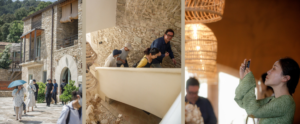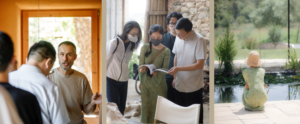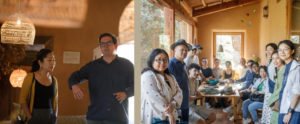On June 11th, we had the opportunity to share an intense and deeply inspiring day with a group of 15 Chinese architects, from various universities in their country, who came to learn about how we work at Bangolo Arquitectura. Their interest was focused on understanding closely an architecture rooted in the territory, connected to traditional techniques, sustainable and aware of its social and environmental context.
Thanks to the architect and friend Xue Ying Wang —resident in Rabós and key as academic guide and translator throughout the route— we were able to explain not only what we do, but how we do it and why we do it this way.

A route between stones, invisible systems and living craftsmanship
The day began at Castell de Vallgornera, a heritage building with a long history, where we have worked on a respectful restoration, which returns use and dignity to spaces such as the large noble room, now finished. France, the host of the castle, received the group with her usual generosity and shared her vision of life and the project.
The second destination was Can Buch, a farmhouse rehabilitated as an ecological rural accommodation. There, beyond the visible architecture, we focused on the support systems that are often hidden: biological water purification, natural ventilation solutions, energy saving strategies. It is a project that shows how efficiency can be naturally integrated into traditional architecture.
We made a technical stop at Can Bolet, in Llorà, a house that stands out for its unique woven wicker facade, a solution that combines formal expression, solar protection and a material dialogue with the immediate environment. The visit generated many questions about construction techniques, durability and local working systems.
The meal was served at El Roura Blanch, Located in a small cobbled square in the centre of the village of Monells, surrounded by stone houses and farmhouses that retain the original character of the area. The restaurant, specialising in traditional Mediterranean cuisine and grilled meats, offered an ideal setting to take a break and continue the conversation in a relaxed manner.
The closing of the day took place at Casa de Fang, at La Pera, a project by architect Oriol Balliu, a close friend and collaborator, where we projected images and opened a conversation around our way of understanding architecture: as a practice rooted in place, aware of resources and deeply human.

A generous exchange rich in learning
Beyond the itinerary, the day stood out for the dialogue that was generated. The visitors’ questions were precise, intelligent and full of respect. There was a sincere interest in understanding how an architecture that recovers techniques such as the Catalan vault —a major protagonist of many of our works— and that relies on natural materials, short circuits and participatory processes is articulated.
In an increasingly globalized world, meetings like this remind us of the value of the local, of the direct transmission of knowledge, of contact with the material and with the people who inhabit it.
We deeply thank all the people who made this day possible: the hosts who opened their doors to us with warmth, Xue Ying for his work and commitment, and the photographer Antonio Navarro Wijkmark, who documented the route with his usual sensitivity.
Architecture, like culture, is also built with shared moments like this.


